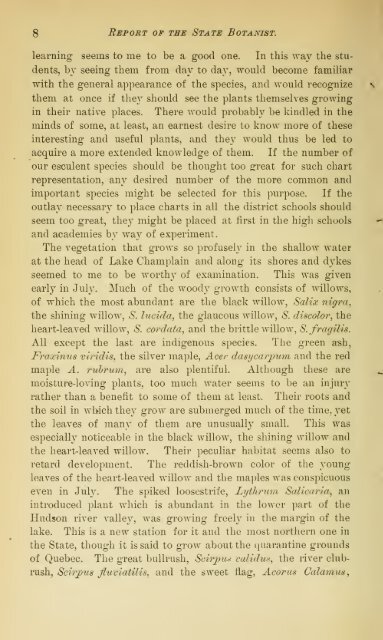Annual Report of the State Botanist 1892 - MykoWeb
Annual Report of the State Botanist 1892 - MykoWeb
Annual Report of the State Botanist 1892 - MykoWeb
Create successful ePaper yourself
Turn your PDF publications into a flip-book with our unique Google optimized e-Paper software.
8<br />
<strong>Report</strong> <strong>of</strong> <strong>the</strong> <strong>State</strong> <strong>Botanist</strong>.<br />
learning seems to me to be a good one. In this way <strong>the</strong> stu-<br />
dents, by seeing <strong>the</strong>m from day to day, would become familiar<br />
with <strong>the</strong> general appearance <strong>of</strong> <strong>the</strong> species, and would recognize<br />
<strong>the</strong>m at once if <strong>the</strong>y should see <strong>the</strong> plants <strong>the</strong>mselves growing<br />
in <strong>the</strong>ir native places. There would probably be kindled in <strong>the</strong><br />
minds <strong>of</strong> some, at least, an earnest desire to know more <strong>of</strong> <strong>the</strong>se<br />
interesting and useful ]3lants, and <strong>the</strong>y would thus be led to<br />
acquire a more extended knowledge <strong>of</strong> <strong>the</strong>m. If <strong>the</strong> number <strong>of</strong><br />
our esculent species should be thought too great for such chart<br />
representation, any desired number <strong>of</strong> <strong>the</strong> more common and<br />
important species might be selected for this purpose. If <strong>the</strong><br />
outla}' necessary to place charts in aU <strong>the</strong> district schools should<br />
seem too great, <strong>the</strong>y might be placed at first in <strong>the</strong> high schools<br />
and academies by way <strong>of</strong> experiment.<br />
The vegetation that grows so pr<strong>of</strong>usely in <strong>the</strong> shallow water<br />
at <strong>the</strong> head <strong>of</strong> Lake Champlain and along its shores and dykes<br />
seemed to me to be worthy <strong>of</strong> examination. This was given<br />
early in July. Much <strong>of</strong> <strong>the</strong> woody growth consists <strong>of</strong> willows,<br />
<strong>of</strong> which <strong>the</strong> most abundant are <strong>the</strong> black willow, Salix nigra,<br />
<strong>the</strong> shining willow, 8. lucida, <strong>the</strong> glaucous willow, S. discolor, <strong>the</strong><br />
heart-leaved willow, S. cordata. and <strong>the</strong> brittle willow, S.fragilis.<br />
AU except <strong>the</strong> last are indigenous species. The green ash,<br />
Fraxinus viridis, <strong>the</strong> silver maple, Acer dasycarpum, and <strong>the</strong> red<br />
maple A. ruhrum, are also plentiful. Although <strong>the</strong>se are<br />
moisture-loving plants, too much water seems to be an injury<br />
ra<strong>the</strong>r than a benefit to some <strong>of</strong> <strong>the</strong>m at least. Their roots and<br />
<strong>the</strong> soil in wMch <strong>the</strong>y grow are submerged much <strong>of</strong> <strong>the</strong> time, yet<br />
<strong>the</strong> leaves <strong>of</strong> many <strong>of</strong> <strong>the</strong>m are unusually small. This was<br />
especially noticeable in <strong>the</strong> black willow, <strong>the</strong> shining willow and<br />
<strong>the</strong> heart-leaved willow. Their peculiar habitat seems also to<br />
retard development. The reddish-brown color <strong>of</strong> <strong>the</strong> young<br />
leaves <strong>of</strong> <strong>the</strong> heart-leaved willow and <strong>the</strong> maples was conspicuous<br />
even in July. The spiked loosestrife, Lythrum Salicaria, an<br />
introduced plant which is abundant in <strong>the</strong> lower part <strong>of</strong> <strong>the</strong><br />
Hudson river valley, was groAving freely in <strong>the</strong> margin <strong>of</strong> <strong>the</strong><br />
lake. This is a new station for it and <strong>the</strong> most nor<strong>the</strong>rn one in<br />
<strong>the</strong> <strong>State</strong>, though it is said to grow about <strong>the</strong> quarantine grounds<br />
<strong>of</strong> Quebec. The great bullrush, Seir^^u.-; validu.^!, <strong>the</strong> river club-<br />
rush, Scirj)us fluviatilis, and <strong>the</strong> sweet flag. Acorns Calainus,
















